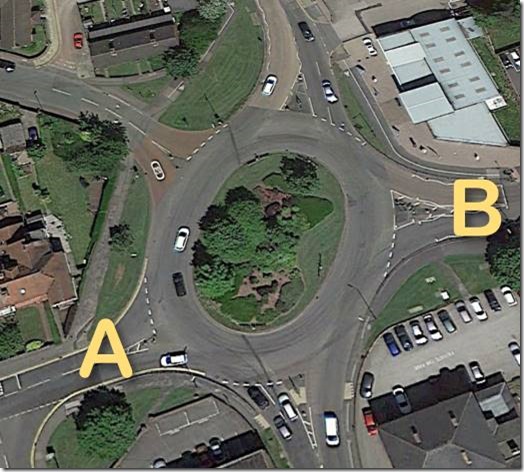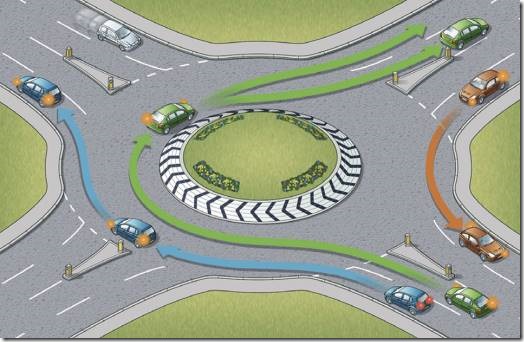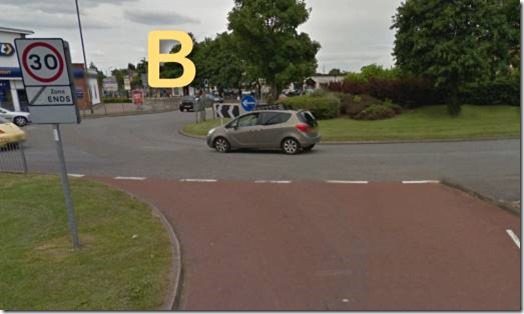A reader has asked for advice on a roundabout in Lichfield (I think the same roundabout is also the subject of a forum debate at the moment). My How to do Roundabouts article continues to be popular, but I thought I’d cover this question separately because that article is quite big.
The question asked by the reader is simply: which lane should I use on the roundabout if I am travelling from A to B?
The question arises – in part, at least – from the fact that although it is “straight ahead” it is not the 2nd but the 3rd exit. The reader also suggests that people using the roundabout all do it differently.
I notice from the forum discussion I mentioned, and assuming that it is the same roundabout they’re talking about, that the “12 o’clock rule” has reared its ugly head again. Let me just clarify: there is no such thing as the 12 o’clock rule, and any such imagined rule has no bearing on how to negotiate this roundabout.
First of all, entry to the roundabout at A is from a single lane, but it is wide enough for two vehicles at the give way line. Two of the five joining roads are clearly marked as two lanes. The roundabout itself is not marked, but it is easily wide enough to accommodate two vehicles side-by-side. Therefore, it is safe to treat the roundabout as having two lanes. The big question is: should you use the left or the right hand lane when travelling A to B?
The Highway Code says the following:
Rule 186
Signals and position. When taking the first exit to the left, unless signs or markings indicate otherwise
- signal left and approach in the left-hand lane
- keep to the left on the roundabout and continue signalling left to leave.
When taking an exit to the right or going full circle, unless signs or markings indicate otherwise
- signal right and approach in the right-hand lane
- keep to the right on the roundabout until you need to change lanes to exit the roundabout
- signal left after you have passed the exit before the one you want.
When taking any intermediate exit, unless signs or markings indicate otherwise
- select the appropriate lane on approach to and on the roundabout
- you should not normally need to signal on approach
- stay in this lane until you need to alter course to exit the roundabout
- signal left after you have passed the exit before the one you want.
- When there are more than three lanes at the entrance to a roundabout, use the most appropriate lane on approach and through it.
That’s not much help with the Lichfield roundabout, is it? I mean, it doesn’t tell you exactly how you should position. However, the picture which is used in the Highway Code, and which I think dates from a time when the rule was more specific, is much more useful.
Note the car with the blue arrow going straight ahead. It is shown in the left hand lane, and this is the default way you should approach a roundabout until you see/know/suspect differently. In fact, if any other positioning is required it will be covered by signs and road markings (if not now, certainly after a few accidents).
So in the case of the Lichfield roundabout, and with A and B being almost directly opposite each other, everything points to using the left hand lane to travel A to B. But what about those who argue you should do it in the right hand lane?
Well, let’s go down to ground level and start considering others using the roundabout. Note that when I refer to exit numbers, these are referenced from road A.
If someone was approaching the roundabout from the 1st exit after A, also intending to take route B, there is absolutely no way that they would use anything other than the left hand lane. Since the roundabout is quite large, the spacing between exits means that it would be perfectly acceptable for traffic to enter it from both A and the 1st exit at the same time under normal circumstances.
Imagine the problems if traffic from A used the right hand lane and both streams arrived at B at the same time. Going one step further, imagine that traffic entering from the 1st exit intended to go straight ahead to the 4th exit (just after B). It would correctly use the left hand lane, but anyone in the right hand lane intending to take route B would then be in avoidable conflict with that stream as they tried to exit across it.
Now obviously, there could be traffic legitimately using the right hand lane (turning right from the 4th exit to take route B, but that would just be normal roundabout behaviour and it shouldn’t cause problems unless someone was driving badly. As for signalling, you would do what you would do at any other normal roundabout when taking an intermediate exit: no signal on approach, and signal left as you pass the exit just before the one you require.
In conclusion, there is no question that drivers taking the path A-B should be using the left hand lane/position on approach, and that they should remain in that position on the roundabout. Since there is no such thing as “the 12 o’clock rule”, that doesn’t come into it at all and it should not alter normal positioning or signalling behaviour.
Finally, a caveat. If absolutely everyone else uses the right hand lane because they know something that strangers don’t, then you seriously have to consider doing it the same way. For example, if traffic backs up on to the roundabout at rush hour, and people use the right hand lane knowing they can cut back across later, there is no reason why you couldn’t do the same – but only when conditions are such that you need to. At other times – and certainly if traffic is as light as it appears on the Google images I’ve used here – you should deal with it properly.